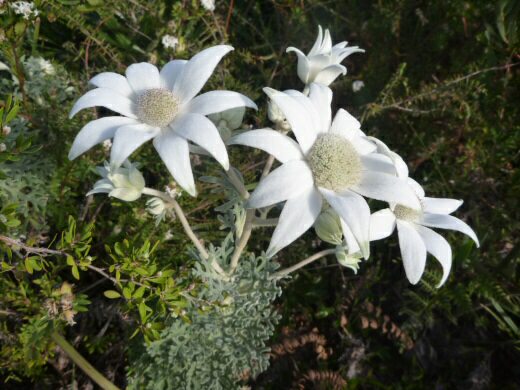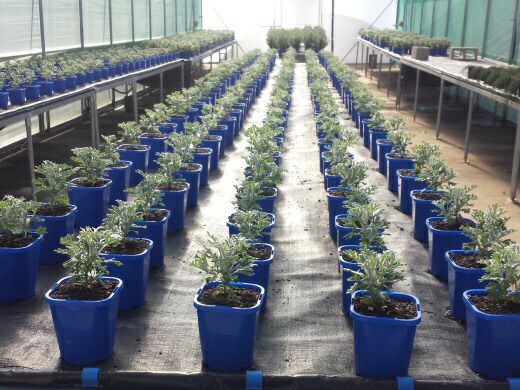The Australian Native Garden is here!
Several years in the making with my co-author AB Bishop (who hails from aptly named Kangaroo Ground near Melbourne), this book continues my journey of wanting to inspire and inform Australian gardeners to use our amazing flora to create gardens that celebrate the sense of place in whatever part of the continent you happen to live. AB Bishop, my co-author, worked with me for several years in her role as researcher for my various stories on Gardening Australia, and during this time I discovered AB’s passion for using indigenous native plants in her garden as part of her desire to help foster her local environment and its flora and fauna.
I see the philosophy of this book as being very much about trying to blend the natural Australian environment with the gardens that we create as humans. AB brings her perspective of using your local flora, while I bring my interest in the various new native plant cultivars that are appearing on the market all the time to fulfil various special needs and wants in our Australian gardens. In addition we have also included a lot of practical stuff including garden design, propagation, bush foods, pests and diseases and deep planting as a ways to make your garden more water wise.
We have developed the book to look at various wild areas around the country, from Western Australia to the arid parts of the Northern Territory, the tropical rainforest of Northern Queensland down to Cradle Mountain in Tasmania. We also look at native gardens in various geographical regions with a view to showing what you can do in diverse climatic and soil conditions. Then there are the practical chapters followed by a comprehensive listing of the new native plant cultivars that have appeared over the last few years, including a few from yours truly. I have introduced the first five selections from my new ‘Tall and Tough’ kangaroo paw range in the native plant cultivar section.
The Australian Native Garden is officially released in book shops around the country on November 18th at a recommended retail price of $50.
Amazing Insects
One of the pleasures of my work is conducting workshops on various matters horticultural and scientific. I recently ran a plant propagation workshop for Central Coast bush regenerators to educate them in seed collection and propagation techniques for local flora. Such workshops always involve an interchange of ideas such that I always learn and expand my own horizons in unexpected ways. At the workshop in question I was intrigued by the amazing gum tree leaf that I was presented with for identification. I drew a blank at the time but promised to see if I could find out. My plant pathologist friend Brett Summerell rapidly came through with the rather astonishing fact that this was a scale insect belonging to the genus Apiomorpha. The mental picture that I form of a scale insect looks nothing like the organism pictured!
My understanding of the science of these extraordinary horn-like structures is that they are created by chemicals that are introduced to the plant when the insects are feeding on the sap. Somehow this commandeers the genetic information of the plant to get it to grow into these amazing structures. Isn’t nature extraordinary?
Pollinators Week (more amazing insects)
I had the pleasure of meeting native bee expert Megan Halcroft whilst working on ABC Radio 702 in Sydney last Saturday morning. Megan is passionate about educating people about the role that native bees play in the Australian environment and particularly their role in the pollination of plants, which is vital for seed set. She has been instrumental in organising an event called Pollinator Week which runs from the 15th to the 21st of November. You can find more details on Megan’s website Bees Business through the following link- http://www.beesbusiness.com.au/index.html
There is also a website called Wild Pollinator Count where you can get involved with pollinator research. They give you lots of info on pollinators and encourage you to get out and count the pollinators for ten minutes in Pollinators Week and submit your results. Get involved on their website- https://wildpollinatorcount.com/
Read more about Australian native bees here
Flannel Flowers
Oh look- kangaroo paws in the flannel flowers!
This time of year always reminds me of how special the flannel flower is as one of our iconic wildflowers. It may surprise you to learn that it is closely related to carrots and celery as part of the worldwide family Apiaceae. It is also closely related to the bush tucker plant sea celery and the Rottnest Island daisy (Trachymene caerulea), which, of course, is not a daisy at all, it just looks superficially like one…..
The biggest flannel flowers I have ever seen were on the Central Coast at Wyrrabalong National Park
Anyway, back to flannels. Actinotus helianthii is the best known of the various flannel flower species which all belong to the genus Actinotus. As well as the best known species there are other intriguing ones such as the pink flannel flower (Actinotus forsythia) and the miniature flannel flower (Actinotus minor). However, the crowd favourite is undoubtedly Actinotus helianthii. It is a very variable species that occurs across a wide range of habitats in NSW and even extends into Southern Queensland. I can recall seeing extensive stands of it across the Pilliga forests of western NSW for instance.
Dwarfed flannel flowers clinging to the windswept coastal cliffs at South West Rocks in NSW
Most of my experience with flannel flower in the wild has, however, been closer to the coast. All along the NSW coastline there are extensive stands, particularly where there are deep sandy soils such as old sand dunes a short distance back from the ocean. There are also beautiful dwarf forms on many coastal headlands. Many of these variations have been collected by researchers working at The Australian Botanic Gardens at Mount Annan in NSW, and through selection and breeding work they have released a superior selection called ‘Starbright’-
https://www.rbgsyd.nsw.gov.au/plants/gardening/growing-flannel-flowers
Flannel flower selection trails at Mount Annan Botanic Gardens
Having spent a lifetime trying to grow flannel flowers myself, I still find them to be something of a ‘drop dead’ plant that will be here one week and gone the next. My understanding is that the biggest problem is root rot and they are particularly susceptible to the root fungus Fusarium that rots the vascular system of the plant. Poor drainage and root disturbance seem to be the factors most commonly associated with plant loss and my own experience is that growing flannel flowers in a sandy, well drained soil or in a pot, and then allowing them to self seed and grow in situ provides the most sustainable result.
November job list
We’re still in spring but not for much longer. My plants are all growing strongly with the warmth and so are the weeds, so there’s lots of garden jobs to do before the heat of summer kicks in. Check out my November job list for some late spring native gardening hints
Bush Tucker Fertiliser Progress
Many of you have taken up the offer in a previous newsletter to trial the new native plant fertiliser ‘Bush Tucker’ that I have been helping to develop. My own trials are progressing very nicely and my kangaroo paws in particular are thriving on the extra nutrition.
Before adding ‘Bush Tucker’ fertilizer After adding ‘Bush Tucker’ fertilizer
Please let me know if you have any feedback, either postitive or negative on ‘Bush Tucker’.








